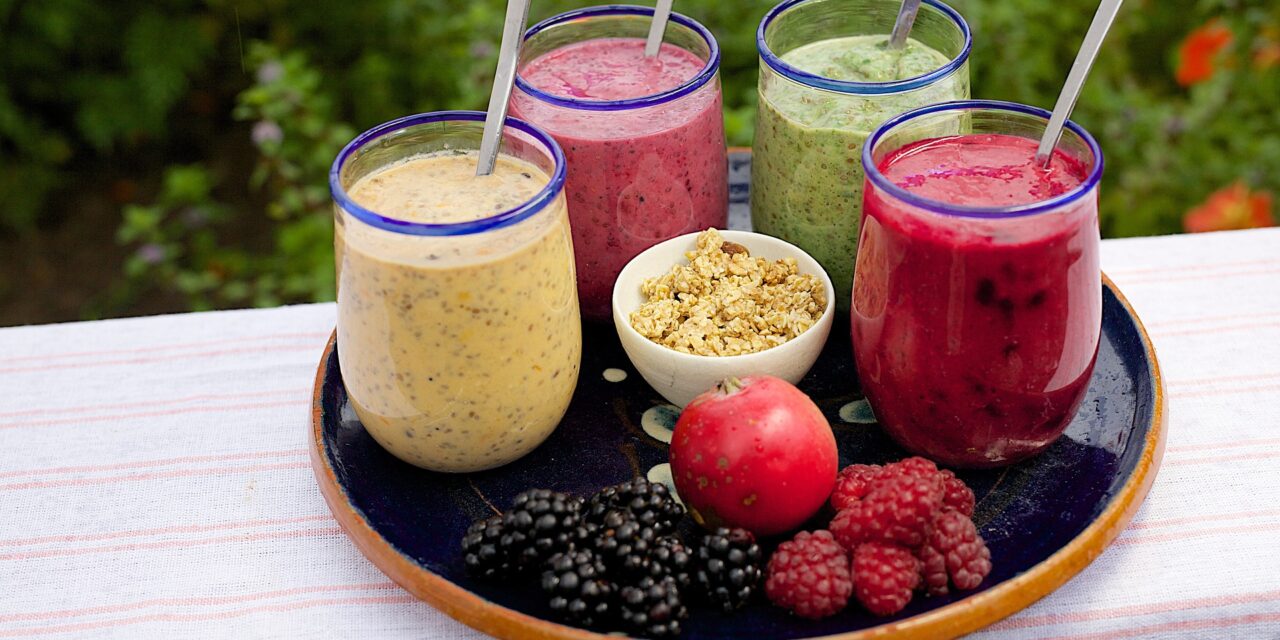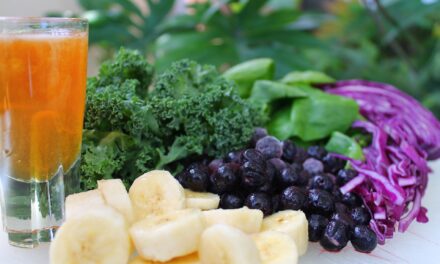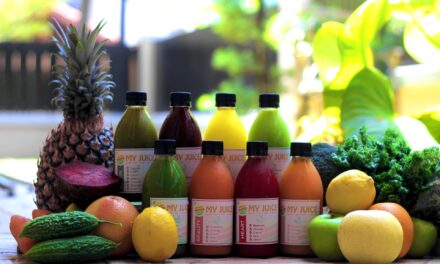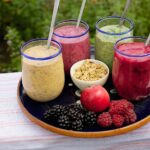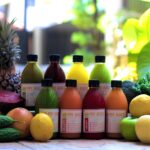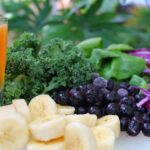You want to get going making homemade smoothies for the family and no doubt have found with blenders as with so many appliances the options are overwhelming so let’s make sure you know exactly which kind of blender suits your needs.
You can blend food in a whole array of different forms and the multi-purpose nature of blenders is certainly very appealing but if your primarily want to use it for making smoothies you need to focus on the ones cut out specifically for the job as we detail below.
If you’re still trying to work out if you actually want to make smoothies or juices you can find clarity on what you really want before you spend your hard earned dollars by reading our blog Juicer vs Blender – Which Should I Buy For My Family?
Types of blenders and terminology
Before we dive into simplifying the blenders for smoothies options here’s clarity on all the types of blenders so you don’t get led astray and can work out what you will really get the use out of overall:
Kitchen Countertop Jug blenders – Varying sizes of jugs sat atop a heavy base, available in a wide variety of sizes and materials plus many additional functionalities – they generally have much more capacity than a single serve or bullet blender – great for making smoothies for all the family
Professional blenders – Commercial quality kitchen countertop jug style with extra power, longevity and functionality to also heat, chop, grind, blend and emulsify a multitude of other culinary delights – much more expensive but a great investment for those that will truly put them to use for more than just smoothies
Bullet / Personal / Single Serve blenders – Cup or bottle sized blenders (some in the shape of a bullet hence the name) – perfect for making smaller smoothies and transporting with special lids and drinking directly from the blender container
Portable blenders – Small and rechargeable blenders for travel or those on the move
Immersion / Stick / Hand blenders – For quick blending of soft fruits for a small smoothie or cooked veg for soups and sauces – some come with attachments for chopping, frothing, whisking and processing also
Kitchen Systems / Blender Combo Systems – One single appliance that covers all your chopping, blending and food processing needs with additional attachments – not only good for smoothies but a solid investment if you will use all of the functions as it saves a great deal of space
Vacuum blenders – For those looking to really maximize their nutritional intake a vacuum blender manages to incorporate less air in the blending process and therefore reduces oxidization and means your drink will have a little longer shelf life
Smoothie Makers – These were blenders that had a tap to pour out the smoothie however they have largely been discontinued as the taps tended to clog and the other blender types above are now what is meant by a smoothie maker
Blender Bottles – Plastic bottles with metal wire ball inside used to mix protein or other kinds of powders with water or your liquid of choice by hand, typically used before or after workouts, just add the liquid and powder, shake and drink
*In addition there are Stand mixers and Hand mixers which often get pulled into the blender conversation as they mix batter which can also be ‘mixed’ in a blender – these are specialist appliances generally for whisking which is why they are often called cake mixers but the quality stand ones designed for for serious bakers have a number of attachments for things like dough and even sometimes blending grinding and cutting tools.
As parents we need any kitchen appliance to make our lives easier
Now you’re a little clearer on the options that are more likely to suit your family and make your life easier we can get down to addressing the pro and cons of each type of blender for your smoothies and whatever else you may like to use them for or you can go straight to our Best 5 Blenders For Busy Families reviews based on the following criteria:
- Affordability (Blenders can range from $45 into the thousands)
- Effectiveness
- Speed and ease of use and cleaning
- Durability and longevity
To make the smartest buying choice it’s most important to be clear on the main things you’ll really use your blender for and make your decision based on which appliance does those things best. To help you easily understand the quality and power, durability, functionality and size that will suit your families needs ask yourself the following questions:
- How often do you feel you will use your blender?
- What will you use it for?
- Are you making for a big family or just a couple of you?
- How much space do you have on your kitchen counter?
Blender features to consider before you buy
Variable speed controls
- One of the main ways the jug blenders stand apart from most of the single use bullet blenders is the ability to control the speed of blending and to ensure that everything is thoroughly mixed to your required consistency
Pulse control
- This feature is super useful in helping you interrupt the blending process to break up more chunky produce and remove any that have got stuck under the blades so you end up with a smooth consistency plus it gives you specific control to create small chunks for things like salsa if you don’t want produce to blend right the way down
Special functionality (more typical with commercial level blenders)
- Many of the higher end blenders have a whole control pad on the front with a choice of customised functions such as “mix”, “puree”, “grind”, “dice” etc… you don’t have to monitor and control the process you just choose your setting and it delivers your desired consistency
Crushed ice
- Only the more powerful options can handle blending ice or anything else that is of a similar hardness so if you like crushed ice you need to look for machines that specifically say they are up for the job or you’ll burn out your motor in super quick time
Capacity
- There is a great variety of sizes from 20 ounces (approximately 2.5 cups intended for single serve portions) up to 90 ounces (approximately 11 cups) – be clear about how much you want to make as it’s annoying having to make multiple batches but equally be mindful of how much countertop space you have
Jug material
- Glass jugs are non-porous so it has the benefit of not staining or retaining any smells or tastes (think garlic pesto followed by a smoothie) but although the glass used is very strong it can be more easy to break, glass blenders tend to be a little more costly and can be very heavy especially when full so factor this in too
- Plastic jugs are the most common as it’s lightweight and the more quality ones don’t easily break or scratch but the plastic varies hugely in quality depending on the model and the cost, most plastics do retain certain smells and can stain from strong ingredients such as turmeric. Many jugs also contain the chemical BPA which research has shown can seep into food and cause a number of health issues especially in children so buying BPA- free is a big consideration for most parents
- Stainless Steel jugs are very popular in commercial settings as they are deemed the most durable and do not stain or pick up smells however they are much more expensive and can obviously dent plus you cannot see what’s happening inside
Dishwasher-safe parts and recipe books included
- The ease of cleaning of dishwasher-safe parts is a feature most parents we speak with that use their blenders regularly could not live without and some blenders come with really invaluable recipes books to help you get the most out of your appliance
Multiple attachments or cordless
- You’ll normally find various attachments with either stick/immersion blenders or or combination systems that operate as both a blender and food processor – in both cases they enable you to perform many different tasks with the same appliance so it’s worth really considering what you want to do with your blender on a regular basis.
- Some stick/immersion blenders are battery operated freeing you from the constraints of the cord which can be extremely helpful but just remember to have extra batteries to hand!
Vacuum blending
- More than an additional feature vacuum blenders are actually a type of blender which essentially draw out the oxygen from the blending container and therefore claim to reduce the oxidization process maintaining a higher level of vitamin and nutrients and have a longer shelf life with less foam and separation forming and even preserve a more vibrant color, taste and texture!
Many blenders will…
- Make sauces, pesto, puree, baby food, batter and cream soups (as long as what you’re producing has a high liquid content to it – the thicker the consistency the harder the machine has to work)
- Chop a small amount like nuts and seeds or harder produce although the lower end models are not ideal for this
- Crush ice and blend frozen fruits although do not presume this as it needs a lot of power to do it without burning out the motor
Most blenders will not…
- Make juice – although some claim to filter the pulp they do not create the type of juice you’d get from a juicer
- Blend hard fruits or veg well unless you add lots of liquid but the drink will still be very thick
- Easily make sauces etc.. of a thick consistency such as hummus or chop or grind large quantities of dry or hard produce as they will stick without the liquid content and the motor can burn out (Commercial blenders and food processors are the ideal tools for these things)
Now you’re clear on some of the things to consider let’s dive into into the types of blenders and their capabilities so you can decide what’s right for you and your family…
Kitchen Countertop Jug blenders & Professional blenders
A countertop blender is a staple in many kitchens due to their usefulness in making not only speedy smoothies a variety of other things such as sauces, mayo, pesto and even soups, nut butters, nut milks, sorbets and ice creams depending on their power and functionality.
It can be so easy to get wooed by the multifunctional, more powerful, larger, more expensive all singing, all dancing machines but unless you genuinely believe you’ll get the use out of the extras detailed below you’ll be wasting your money.
What do Countertop Jug blenders do best?
- Blend drinks like smoothies, milkshakes and cocktails – keep in mind they are designed for liquids!
What are the main benefits of Countertop Jug blenders?
- Larger capacity
- Can generally handle slightly thicker mixtures
- Most have speed and pulse controls and many have special functionalities
- Those with 1000 watts of power or more will generally crush ice and blend frozen fruits without damaging the motor
What are the potential drawbacks of Countertop Jug blenders?
- They can take up lots of space in your kitchen
- They are not food processors or juicers and it pays to know the difference
What are the main benefits of Professional blenders?
The higher end blenders deemed to be at or near the commercial level are not necessary for most families however if you are planning to really put your machine to use everyday and blend more substantial produce you may want to consider the investment of the extra power, functionality and performance that they provide.
- More powerful motors and stronger build quality
- Built to last no matter the usage – often used in restaurants
- Blends thicker dips like hummus, iced drinks, chop and grind and make nut butters and nut milks and in some cases can actually cook soup and make ice cream!
- Designed to stop produce getting stuck at the bottom under the blade
- Some premium versions have covers that dampen the sound
- For the tech lovers some can be pre-programmed and even have touchscreen bluetooth/wireless technology
- Some have self cleaning blades or functionality
What are the potential drawbacks of Professional blenders?
- They can be a considerable step up in cost (really should be seen as a long term investment)
- Take up much more space
- Many people find themselves dazzled by the idea of all the functionality but in fact don’t use a fraction of it
- Some models have been deemed difficult to clean but this can be easily dealt with by adding water and dishwashing liquid and turning the machine on
Countertop Jug blenders and Professional blenders price range?
- $45 – $1500 + (Typically commercial quality blenders come in at between $299 and $600 but there are the premium versions with the larger price ticket and brands like Ninja giving the likes of Vitamix and Blendtec a run for their money with great quality machines starting at around $120)
Recommendations for Countertop Jug and Professional blenders
- Be careful not to drop any spoons or utensils or foreign objects into the mix or you will likely damage the blades and or motor
- Ideally chose a blender with a proper spout for pouring as pouring from the corner of the jug can get messy
- Apart from the some of the very high end blenders that are actually designed to heat soups for example do not blend hot liquids as they can combust or spurt out hot liquid or steam and burn you when you open the lid (when blending cooked soups wait for them to cool first)
- Go for 3 – 10 variable speed settings to give you the best control
- It’s always best to clean directly after use and buy dishwasher safe for ease of cleaning and for stubborn residue add water and dishwashing liquid to the jug and blending for a couple of seconds
- Buy BPA free containers for safety
- Remember to buy based on the functionality you will actually use
Bullet / Personal / Single Serve blenders
The key to this type of blender is that they are compact and blend directly into a container you can drink straight out of or carry with you and to avoid any confusion it’s important to remember the various names are just different ways to refer to the same thing.
What do Bullet / Personal / Single Serve blenders do best?
- As per jug blenders they are ideally designed for liquids such as smoothies, milkshakes and cocktails but the more powerful versions will handle sauces, pesto, puree, baby food, batter, creaming soups (once cool), chop small amounts of nuts, seeds and harder produce and some will even blend frozen fruits.
What are the main benefits of Bullet / Personal / Single Serve
blenders?
- Take up very little space
- Blending straight into the cup saves time and washing up
- Typically high powered regardless of their size and super fast
- Although they are referred to as single size the larger cups can hold at least 2 drinks worth of liquid
- Easy to transport (I’ve often taken mine on trips in my suitcase)
What are the potential drawbacks of Bullet / Personal / Single Serve blenders?
- Go for a quality brand to avoid leakage and the ability to power through the harder items like nuts and seeds
- If you screw the lids on too tight to avoid leakage it can be incredibly hard to unscrew it
- Many only have an on / off mode so you don’t get to control the speed and sometimes items get stuck in the blades and you have to shake the cup manually but there are now models with variable speed and pulse controls
- Although many technically will do the job it’s often recommended not to use them for crushing ice
Bullet / Personal / Single Serve blenders price range?
- $30 – $130 +
Recommendations for Bullet / Personal / Single Serve blenders
- Don’t buy too cheap as leakage is often a problem with the lower end machines
- Look for models with different blades for both chopping and blending
- Never blend hot liquids as they can combust or spurt out hot liquid or steam and burn you when you open the lid (when blending cooked soups wait for them to cool first)
- If you want more control look for models with variable speed settings and pulse and to avoid produce sticking under the blades
- Buy BPA free to ensure no chemical seepage from the containers into your drinks and dishwasher safe for easy washing – ideally wash immediately after use to prevent any stubborn residue forming
Portable blenders
The next evolution from the single serve / bullet countertop style blender is the portable blender. Although technically the bullet type is quite portable we are now talking cordless, pop in your handbag style which makes blending on the go a real thing!
What do Single Portable blenders do best?
- Blend soft produce and liquids when you’re not at home – think office or gym smoothies and fresh pureed baby food on the go!
What are the main benefits of Portable blenders?
- The smallest most lightweight and portable form of blender
- Allow you to make fresh smoothies at any point in the day and drink them straight away while the maximum nutrient content is in tact
- Cordless – most have a rechargeable motor that charges via a USB port
- As per the bullet style the blend straight into the cup saving time and washing up
What are the potential drawbacks of Portable blenders?
- They can leak – ensure you tighten both ends fully and don’t overfill them and buy quality brands that don’t have reports of this issue
- They can run out of battery – like with your phone they’re great till they run out of juice so don’t forget to take your charger with you!
- Naturally they tend to be less powerful and can only really deal with softer produce
- Most only have an on / off mode so you don’t get the control you find with more substantial blenders
Portable blenders price range?
- $20 – $110 +
Recommendations for Portable blenders
- Don’t buy too cheap as leakage seem to be a theme with the lower end machines
- Keep them upright in your bag whilst transporting with liquids inside
- Never blend hot liquids as they can combust or spurt out hot liquid or steam and burn you
- Buy BPA free to ensure no chemical seepage from the containers into your drinks and dishwasher safe for easy washing – ideally wash immediately after use to prevent any stubborn residue forming
Immersion / Stick / Handheld blenders
Immersion blenders are held by hand and their long stick is immersed into whatever you are choosing to blend hence the various popular names used for this type of blender.
What do Immersion / Stick / Handheld blenders do best?
- Small volume, quick, lightweight blending (think smoothies for 1, dips, pesto, mayonnaise etc…) and when it’s easier to ‘immerse’ your blender in the pot your cooking in such as in the case of soups
What are the main benefits of Immersion / Stick / Handheld blenders?
- Lightweight and convenient, can be immerse directly into the container or pot that you wish to blend in and easy to use and wash
What are the potential drawbacks Immersion / Stick / Handheld blenders?
- They will struggle with heavy duty blending, chopping or pureeing jobs as their blades and motors are much smaller and will not generally blend to a silky smooth texture
Immersion / Stick / Handheld blenders price range?
- $25 – $150 +
Recommendations for Immersion / Stick / Handheld blenders
- It’s advisable to invest in a model with the extra attachments for chopping, whisking, frothing and processing to maximize the benefits but only if you will use them
- Wider blade guards with larger vents allow more space for the blending process and helps avoid produce getting stuck
- Non slip rubber handles can be easier to grip
- Cordless options are ultra convenient with no wire to get in the way but make sure you have extra batteries on hand
- Avoid using them for hard or fibrous produce or for prolonged periods or the motor will burn out
- Choose BPA free with dishwasher-safe parts
Kitchen Systems / Blender Combo Systems
Blender and food processor combination machines – one heavy duty base with the specific attachments for both blending and food processing.
Contrary to popular opinion blenders are not food processors and although the higher quality ones do some food processing tasks quite well in small batches they are fundamentally designed for blending high liquid content and do not have the same capacity for chopping and mixing harder and thicker produce especially in larger volume.
What do Kitchen / Blender Combo Systems do best?
- Nearly everything! – They blend, mix, emulsify, puree, chop, dice, slice, grate, mill, grind, knead, whisk all produce through from liquids to hard produce and sticky dough
What are the main benefits of Kitchen / Blender Combo Systems?
- All in one system for most kitchen needs
- Only takes up the space of one machine but does the job of many!
- Powerful machines with capacity for blending or processing large batches
- Time saving
What are the potential drawbacks of Kitchen / Blender Combo Systems?
- Some model skimp on capacity – look for models with larger containers if you are using it for a family
- There’s a certain investment of time to learn and understand all the controls, food processors are often the types of machines that end up languishing in cupboards or not being used to their full potential
- The food processor element can be a bit of a faff to clean
- Can be very noisy
Kitchen / Blender Combo Systems price range?
- $140 – $1000 +
Recommendations for Kitchen / Blender Combo Systems
- You need a comprehensive instruction and recipe book and online support and training if possible
- Check what attachments are included as sometimes you can get caught out with having to buy extras to complete the tasks you want to do
- Make sure safety features like non slip feet locking lid and cap for the lid are as standard plus temperature limits and some have handy blade storage drawers
- Look for larger feeder tubes to minimize prep needed
- Choose BPA free with dishwasher-safe parts
~Discover your families own path to healthy eating happiness~

